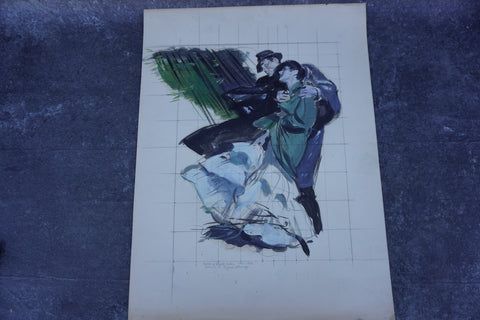Léa Lafugie - A Lady Powdering Her Nose - Fashion Pochoir - Boudoir Art c 1920s P2562
Well, first, what is a boudoir, really? It is a woman's private space, for reading a book, or to collect her thoughts, even to just plain simmer down (the word is derived from the French verb bouder, to sulk), and, sometimes, to receive a friend... or a lover. And Boudoir Art? Paintings and prints, usually quite small, that speak to her femininity: images of fashion, and romantic courtship usually, and not to be confused with boudoir photography by a long shot. And these lovely works achieved a certain perfection in the first decades of the 20th Century.
What woman wouldn't want to be her, in a totally knockout gown, hair perfect, all elegant and soignée? These don't come any better than this exquisite example..
The art is 7" in diameter, and the frame measures 10 3/4" x 10 3/4". In excellent condition. From a collector.
Léa Lafugie was born in France and at the age of 16 she entered the School of Decorative Arts of Paris. In 1925 she began traveling the world, first to Sri Lanka, then India, where she held many exhibitions and painted portraits of Mahatma Gandhi and the poet Rabindranath Tagore. She subsequently traveled to Tibet, Southeast Asia, China, and Japan.
The pochoir process, characterized by its crisp lines and brilliant colors, produces images that have a freshly printed or wet appearance.
Pochoir plates were regularly used in French fashion journals, such as Le Jardin des Dames et des Modes and the Gazette du Bon Ton: arts, modes & frivolités, created by well-known artists such as George Barbier, to illustrate costume styles and set the tone for haute couture in the first half of the 20th century. Pochoir images are also contained in illustrated French industrial design, interiors, textile, and architecture folios produced primarily in the 1920's and 1930's that document and promote the Art Nouveau and Art Deco style. French pattern books of this period, consisting entirely of pochoir images of floral, insect-animal, and geometric forms, were created to inspire primarily fabric, interior and wallpaper designers.
Pochoir is a refined stencil-based technique employed to create prints or to add color to pre-existing prints. It was most popular from the late 19th century through the 1930's with its center of activity in Paris. Pochoir was primarily used to create prints devoted to fashion, patterns, and architectural design and is most often associated with Art Nouveau and Art Deco. The use of stencils dates back to as early as 500 C.E. and was also used in Europe from the 1500's onward to decorate playing cards, postcards and to create simple prints. It was, however, the increase in popularity of Japanese prints in the middle of the 19th century that spurred the refinement of the use of stencils culminating in the development of pochoir. At the peak of its popularity in the early 20th century, there were as many as thirty graphic design studios in France, each employing up to 600 workers.











